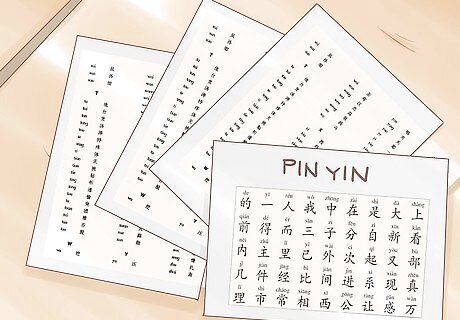
views
Choose a Chinese language to focus on.

Decide if you are going to learn Cantonese or Mandarin. Many people think Mandarin and Cantonese are dialects of the same language, when in reality, they are entirely seperate languages. This means it's important to decide on which one you want to learn. Mandarin is spoken the most in mainland China so it may be a good option if you are planning a trip to China or want to be able to speak to mainlanders. Cantonese is spoken more in North America so it may be ideal if you want to communicate with Chinese people in Canada or the United States. Mandarin is also often used in business transactions between China and North America so if you plan to do business with Chinese companies, it may be more practical for you to learn. There are many other languages of Chinese but Mandarin and Cantonese are the two most commonly spoken.
Study the 4 tones in Mandarin.

Chinese is a tonal language, which means it uses pronunciation to create meaning. The same word, said in a different tone, can mean something else. Learning the tones is best done by listening to how they sound and repeating the tones as much as you can. Making mistakes where you say a word with the wrong tone is common, and part of the learning process. You will need to practice and master the tones to speak Mandarin properly. Mandarin has 4 tones: Tone 1: Level Tone 2: Rising Tone 3: Departing Tone 4: Entering/stop-final
Learn the 6 tones in Cantonese.

Cantonese is a bit more complicated when it comes to tones, as it has 2 more than Mandarin. You will need to adjust the pitch of your voice to match the correct tone so you are speaking Cantonese properly. The tones in Cantonese are: Tone 1: High Tone 2: Rising Tone 3: Mid Tone 4: Low-mid to low Tone 5: Low to low-mid Tone 6: Low-mid
Practice simple phrases.

Practice basic phrases like “hello,” “thank you,” and “goodbye.” Start with basic conversational Chinese so you can get familiar with the language. Look up the Mandarin or Cantonese words for greetings like “hello” or “welcome.” Make sure you know how to say “thank you,” “goodbye,” and “how are you?” For example, in Mandarin, the word for “hello” is “ni hao” for a casual conversation and “nin hao” for a formal conversation, such as with a boss or business associate. In Cantonese, “hello” is “Neih hou.”
Focus on learning nouns and verbs.

Rather than try to learn vocabulary or a long list of terms, try to learn basic nouns and verbs instead. Nouns like “I,” “we,” “she,” “he,” and “they” are good building blocks for simple sentences. Verbs like “go,” “walk,” “run,” “visit,” and “meet” will be useful in many conversations and help you speak full sentences in Chinese quickly. For example, you may learn a simple sentence like “I visit Beijing” by learning how to say “I” “visit” and “Beijing” and putting the words together to form the sentence. Start by learning to put together sentences that are 3-4 words long. Over time, you can add on words to learn longer sentences.
Learn how to count in Chinese.

Start by learning how to count from 1-50 in Mandarin or Cantonese. Listen to the pronunciation of the numbers using an audiobook or an audio tool. Note how to write each number using Chinese characters and Pinyin. Once you master 1-50, challenge yourself to learn 50-100 and beyond. You can find a list of numbers in Mandarin on Omniglot.com: https://www.omniglot.com/language/numbers/chinese.htm. You can find a list of numbers in Cantonese on Omniglot.com: https://www.omniglot.com/language/numbers/cantonese.htm.
Practice writing in Pinyin.

Pinyin is a system devised to write Chinese characters using phonetic spelling. It can be a helpful way to learn how to write in Chinese without having to study the thousands of characters in the language. The Pinyin for words will be based on the tones in the word. You will need to study the tones and Pinyin at the same time. You can write in pinyin on your computer by adjusting the settings on your Mac or PC. Typing Pinyin to others can help you become more familiar with the system.
Learn simplified Chinese characters.

Simplified characters were designed to make writing Chinese more accessible. These characters require fewer strokes and are usually easier to learn than traditional characters. Start by studying simplified characters that are only 1-2 strokes. Then, learn more complicated terms that have 3-4 strokes. Get a book on simplified Chinese characters and start with the 1-2 stroke ones. Practice writing them and memorize the word or phrase they represent. Then, attempt more complicated characters once you have gotten the hang of basic ones.
Use flashcards with images and Pinyin.

Create flashcards with the Pinyin on one side and an image of the object or person it represents on the other side. Practice with the flashcards so you can memorize the correct Pinyin for the object or person. Say the Chinese word or phrase aloud so you can remember it. Quiz yourself with the flashcards or ask a friend to quiz you. Add more challenging words and phrases to the flashcards as your Chinese improves.
Listen to Chinese radio stations.

Chinese music and songs are another great audio resource you can use to improve your Chinese fast. Tune in to Chinese radio stations and keep it on in the background so you can sing along to Chinese words and phrases. Listen to the lyrics in the songs to get better at your pronunciation and tones. You can also find CDs or music online by Chinese artists and listen to it to help you learn the language.
Watch Chinese movies and television shows.

Set aside time once a day to watch a movie in Chinese or a television show. Listen to how the words are spoken in conversation. Note the tones used as well as the phrasing. Stick to watching one television show at a time. Watch movies featuring the same actors or actresses so their dialogue becomes familiar to you. Try watching a Chinese anime for simple dialogue and vocabulary. Challenge yourself to watch a Chinese soap opera or a movie with a lot of dialogue for more difficult conversations. Look for Chinese movies and television shows at your local library or online. Expert Answer Q When asked, “How can you get better at Chinese fast?” Godspeed Chen Godspeed Chen Native Chinese Speaker & Translator Godspeed Chen is a Professional Translator from China. He has been working in translation and localization for over 15 years. Godspeed Chen EXPERT ADVICE Answer from Godspeed Chen: Godspeed Chen, a Chinese translator, responded: “The best method is to listen to spoken Chinese as often as possible. You should also read more Chinese characters and try to speak the language a lot.”
Use a Chinese language app.

There are many apps you can download onto your smartphone, tablet, or computer to help you improve your pronunciation and tones. Look for apps that focus on basic nouns and verbs or getting better at Pinyin. Use the app during your study sessions to look up the pronunciation of a word and improve your tones when you are practicing conversational Chinese. You can also use apps to help you learn how to write Chinese characters. Apps like Skitter, FluentU, Chinese Pod, and The Chairman’s Bao are all good options.
Go to Chinese restaurants and order in Chinese.

Improve your conversational Chinese by trying to order your food and drink in Chinese at a local Chinese restaurant or cafe. Make sure the waiter speaks Mandarin or Cantonese, depending on which one you are learning. Greet the waiter in Chinese and put in your order, describing items on the menu in Chinese. You can also ask for the bill in Chinese and thank the waiter for their service. Keep in mind you may make a mistake when you try to order in Chinese. Accept this and push on, as you will then learn from your mistakes and order correctly next time.
Make a Chinese friend and speak Chinese with them.

Contact a language school near you to see if they have any Chinese students who would be willing to practice with you. Post an advertisement online for a native Chinese speaker you can practice your Chinese with. Ask friends if they have any Chinese friends who would be willing to talk to you in conversational Chinese. When you find a Chinese friend to practice with, make weekly dates with them where you get together and speak in Chinese only.
Get a Chinese language tutor.

The tutor can help you improve your basic Chinese speaking skills and do exercises with you to expand your vocabulary. They can also correct you when you make mistakes and give you feedback on your progress. Look for a Chinese language tutor at a local language school or through an online tutoring service. You can also search for a Chinese language tutor at your local university or college, especially if they have a Chinese language studies program.




















Comments
0 comment